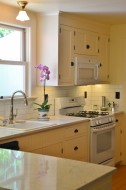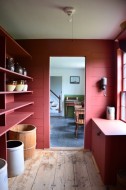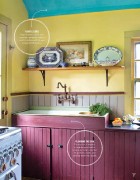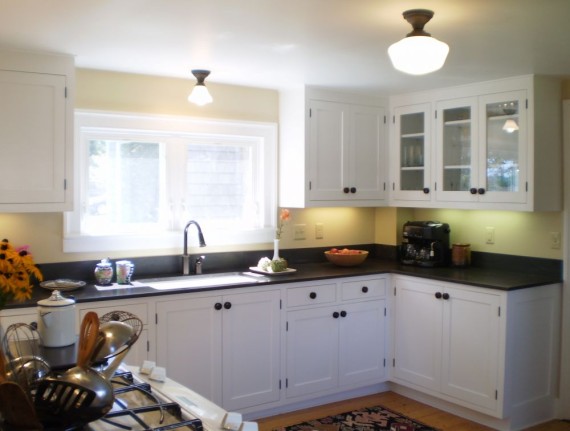
The Devil's in the Details
August 18, 2010
We never build the same kitchen twice, but the challenge is always the same - to create a space that is both elegant and functional. Serving not only the user's culinary and domestic needs, but reflecting sensitive and thoughtful values that elevate the spirit. Heady goals for a humble kitchen? Why not?
Each completed kitchen must be as unique as the home and the client that occupies it. Letting the house speak to you - may sound corny - but it's a good place to start. Maintaining the home's integrity, even when faced with the inevitable updating, is not only desirable, but downright essential. Its more than just a worn cliche; if you respect an old house it will thank you. We allowed this home to guide us; from trim to cabinets to finishing touches.
For the Eastport kitchen remodel we decided to keep it simple - drawing from the home's intact Federal detailing - adding references to Shaker, English country and an 1840's butler's pantry. The Federal Style, inspired by Greek, Roman and Egyptian architecture, came to symbolize the emerging ideals and aspirations of the new American democracy. This home's scaled down version has a quiet dignity, reflecting its individual connection to community, while expressing simple values of order and respect for "finer feelings."
The early kitchen with its beaded baseboard and chair-rail extending all the way around the room would have been furnished largely with free standing pieces. Perhaps a dry sink, hutch and rocking chair - a large work table with ladder-back chairs for a 'sit down' or 'cards'- and a rough wood box to feed the cooking fireplace. Since we were building traditional cabinets for a modern home we had to take a different approach.
We took our cue from 'built-ins' we had seen in grander homes surviving from the early nineteenth century. Plain spare cabinets create a counterpoint to ogee and beaded door and window trim. Cabinet doors mirror mortise and tenon interior doors we'd found onsite. We applied the same type of panel to each exposed cabinet end. We always dovetail our drawers for strength and beauty. In the nineteenth century they were cut by hand - today we use a jig and router. Varying the size of the rails and styles added interest and improved function. 1 and 2 inches on the face frame - 2 ½ and 3 inches on the doors. The cabinets were inset 1 inch from the trim - creating a nice outline and allowing room for the countertop's edge. Small slices of the original baseboard were tacked in to fill the gap at the bottom suggesting the former - continuous run.
For lighting and fixtures we blended old and new. We chose a classic line from Rejuvenation (a company that makes period reproductions), opting for an antique, oil-rubbed bronze finish. Nickel would have made it too specific to the 1930s; shiny brass the 1890s. This color was extended to ball-tipped hinges, faucet and drain. The Moen (one handed) faucet - with its modern sculpted features is a bit oversized, but looks surprisingly traditional - reminiscent of an old-time hand operated water pump.
The knobs for the cabinetry were slated to be oil-rubbed bronze as well. A 'middle of the night' revelation changed that plan completely. The cool touch and modern feel of the metal just didn't seem right. During an early inspection we found that the home still sported a few distinctive, hand turned mahogany knobs more than common in the Federal period. They were widely used on Empire furniture - the corresponding French style. It seemed obvious they should be on our built-in 'furniture' as well. The warmth and natural beauty of a wooden knob would feel much better and it would provide a further connection to the old house. Dark walnut was substituted for mahogany, to compliment the bronze.
Our choice was given additional support several days later. A Home Depot run to Ellsworth provided an opportunity to visit Woodlawn House Museum. While on the tour we peered in the butler's pantry. There was our vision - white painted cabinets with the dark mahogany (Empire) knobs. It was a beautiful fit and definitely the way to go!
We choose a slightly oversized version (to add distinction) - stained all thirty-six- rubbed them smooth with extra fine steel wool - then a couple coats of tung oil. We used dark antique brass reproduction turns (similar to those also surviving elsewhere in the house) to secure the new pantry cabinet's doors, as a nice traditional touch. It is little details like this that can make all the difference.
All the oil-rubbed bronze fixtures are complimented by the Corian countertop color - Earth, the previously sanded and finished pine board floors (protected with Ram Board for the renovation) and walls painted with the Benjamin Moore historic color - Monroe Bisque (which turned out to be one of the room's early colors). The trim in the rest of the house is white, so we went with classic white for the cabinets as well, to maintain continuity. White appliances were chosen to blend with the cabinets - creating a more seamless look. The stove is back in the traditional cooking spot; you can still see (on the floor) the mitered corners that surrounded the old hearth stone. The slide-in version allows the Corian backsplash to span the whole fireplace wall - giving it a really built-in look.
After all the planning, figuring and building is done it's the time to stand back and see how our careful choosing has added up. The final product is something you just can't see on 'paper.' The look invariably surprises - even us. In this case, dare I say, pure heaven.
For more photos of the project click here
(click photo to view larger image)
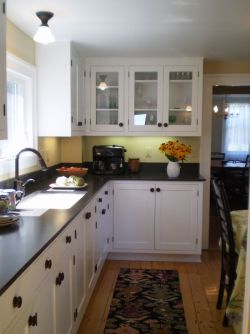
|
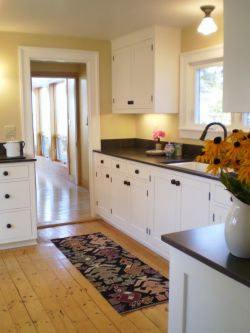
|
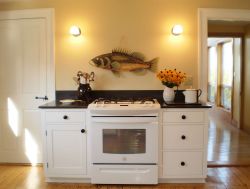
|
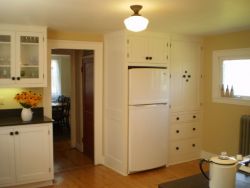
|
(comments = 0)
leave a comment

fineartistmade blog
A journal about home design, gardening, art & all things Maine. Read more...
- June 2025
- December 2022
- November 2022
- October 2022
- November 2021
- May 2020
- October 2019
- August 2019
- July 2019
- September 2018
- April 2018
- December 2017
- August 2017
- June 2017
- May 2017
- December 2016
- August 2016
- July 2016
- April 2016
- November 2015
- June 2015
- May 2015
- March 2015
- October 2014
- March 2014
- February 2014
- January 2014
- December 2013
- November 2013
- July 2013
- May 2013
- April 2013
- March 2013
- January 2013
- December 2012
- November 2012
- August 2012
- June 2012
- April 2012
- March 2012
- February 2012
- January 2012
- December 2011
- October 2011
- August 2011
- July 2011
- June 2011
- May 2011
- April 2011
- March 2011
- February 2011
- January 2011
- December 2010
- November 2010
- October 2010
- September 2010
- August 2010
- July 2010
- June 2010
- May 2010
- My Scandinavian Home
- Daytonian in Manhattan
- {frolic!}
- I Married An Irish Farmer
- Smitten Kitchen
- The Curated House
- even*cleveland
- Mary Swenson | a scrapbook
- Ill Seen, Ill Said
- Gross & Daley Photography
- Remodelista
- Abby Goes Design Scouting
- Mint
- the marion house book
- 3191 Miles Apart
- Svatava
- Katy Elliott
- Poppytalk
- Kiosk
- decor8
- KBCULTURE
- Lari Washburn

